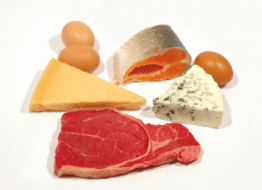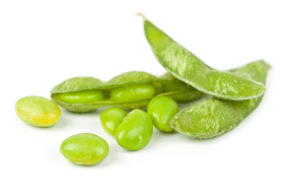Daily Protein Intake
The Benefits of Protein for Muscle Growth, Weight Loss and Optimal Health
Your daily protein intake plays a vital role in whether you want to lose body fat, build muscle or improve your overall health and well-being.
Achieving your daily protein intake is not that difficult, provided you eat a variety of different protein foods at every meal.
Proteins are made up of building blocks called amino acids. Amino acids are referred to as essential and non-essential. Non-essential amino acids are those that the body can produce. Essential amino acids are those that the body cannot produce. Therefore, you must obtain them from your food sources or nutritional protein supplements.
Protein comes from two food sources: animal and plant foods. All proteins are not created equal, and you may have wondered whether some protein sources are better than others. The "gold standard" of determining protein quality is the Protein Digestibility Corrected Amino Acid Score (PDCAAS), based on human amino acid requirements. It is a value that measures how well the body can absorb and utilise a protein. The higher the PDCAAS value of a protein, the better the body can use it. The highest possible score is 1.0.
To give you an idea, eggs, cow's milk, whey protein, and soy protein have a PDCAAS of 1.0. Beef, chicken and fish have a score of 0.90 and above. Peas have a score of 0.73 and rice 0.47. Plant protein generally has a lower score than animal protein sources.

Animal foods
Animal foods such as eggs, red meat, chicken, turkey, fish and dairy products are a complete source of protein because they contain all the essential amino acids your body needs. They are also rich in other minerals like zinc and iron.
Plant foods
Although animal proteins have been said to be the best provider of our protein requirements, you can still receive complete protein from plant foods.

When combined, plant proteins can provide a complete form of protein because their amino acids complement one another. Suppose you consume an adequate quantity and variety of plant foods, including whole grains, legumes, nuts and vegetables. In that case, you can naturally achieve your protein intake and get all the essential amino acids your body needs.
Soy is a complete protein and contains all the essential amino acids. If possible, choose organic, non-GMO soy foods or soy foods that have been fermented, like tempeh.
Quinoa, a grain-like plant that originated from South America, has also become a popular source of protein. It is also rich in minerals like calcium, phosphorous and iron. Quinoa can also be used as an alternative to rice.

Which sources of protein should I choose?
Choose what works best for you. If you prefer to consume animal foods as your primary source of protein, try to choose lean and, as much as possible, organic, grass-fed, free-range and hormone-free. Complement them with plenty of leafy greens and vegetables to get your complex carbohydrates and fibre.
If you choose to have only plant-based food sources, ensure it's a good variety combining whole grains, legumes, nuts and seeds. And if possible, try and choose organic and non-GMO sources.
Protein Supplements
If you cannot get all your daily protein intake from whole foods, protein supplements can help. The most popular protein supplements are made from whey concentrate or isolate. Other supplements are made from milk, egg, soy, beef, rice, pea, potato, and hemp protein formulas.
I use a pea and sometimes whey protein supplement from The Healthy Chef.
For more information on protein powders, click to view an article from Precision Nutrition - All about protein powders.
How to calculate your daily protein intake
Calculate your protein intake relative to your body weight and goals.
If you have a specific goal, such as fat loss or building muscle, the best way to calculate your protein is by using your current lean body weight (LBW). LBW is your total body weight, less the body fat. For example, an 80 kg (176 lb) person with 20% body fat would have a LBW of 64 kg (141 lb).
About 0.8 grams per kilogram of body mass is enough to cover basic daily requirements for sedentary, generally healthy adults.
If you eat a variety of foods, you should have no problem achieving the minimum protein intake.
However, you may need more protein if you're more active, exercise often, and have a weight loss or muscle-building goal. Organisations like the American College of Sports Medicine, Academy of Nutrition and Dietetics and International Society of Sports Nutrition recommend a protein intake of between 1.2 to 2.0 grams per kg of body mass.
For example, let's take our 80 kg person above with 20% body fat with a goal to reduce body fat while retaining muscle. Based on their LBW of 64 kg, their protein intake would be between 77 to 128 grams of protein per day.
I prefer to have at least 1.5 grams of protein per kilogram of LBW because of my exercise volume.
Tips for a healthy daily protein intake
I prefer to get my daily protein intake from plant and animal foods. I also supplement my diet with a quality nutritional protein shake mentioned above.
Getting protein from a variety of plant and animal sources makes it easier to achieve your daily protein intake. Here are a few tips to achieve your daily protein intake:
Eat protein at every meal
Spread protein intake throughout the day. A good habit to get into is to eat protein at every meal.
Instead of consuming a large amount of protein in one meal, distribute it evenly throughout the day. This helps optimise muscle protein synthesis and supports overall protein utilisation.
For example, if you have a daily protein intake of 90 grams and eat three meals a day, you can divide your protein intake evenly and have 30 grams at each meal.
Maintain the minimum based on your body weight and goals
About 0.8 grams per kilogram of body mass is enough to cover basic daily requirements for sedentary, generally healthy adults.
Remember that the more you exercise or if you have a weight loss or muscle-building goal, the more protein you may need. Athletes and individuals engaged in intense physical activity may require more as well.
Choose good quality sources of animal foods
Wherever possible, choose organic, grass-fed or free-range products to avoid possible contamination with growth hormones and antibiotics.
Better options are pastured eggs, and lean cuts of meat like chicken, turkey, beef, lamb and pork tenderloin.
Include fish and seafood
Fish is an excellent source of protein and good fats like salmon, tuna, trout and sardines.
Include plant-based protein sources
If you follow a vegetarian or vegan diet, include plant-based protein, preferably from organic, non-GMO sources like legumes (beans, lentils, chickpeas), tofu, tempeh, quinoa, edamame, rice and seeds.
Dairy products
If you aren't intolerant or sensitive to lactose or dairy, dairy products are a good source of protein like milk, yoghurt and cheese. Choose organic or biodynamic dairy products free from artificial or synthetic chemicals, fertilisers, GMOs or any unnecessary additives if possible.
Include protein-rich snacks
Incorporate protein-rich snacks into your daily routine to meet your protein needs. Examples include Greek yogurt, cottage cheese, protein bars, hard-boiled eggs, or a handful of nuts.
Eat a protein-rich breakfast
Start your day with a protein-rich breakfast to keep you full and satisfied throughout the morning. This could be eggs, Greek yogurt, protein smoothies, or oatmeal topped with nuts or seeds.
Consider protein supplements
Protein supplements can be convenient options if you struggle to meet your protein requirements through whole foods alone. However, it's always best to prioritise whole food sources whenever possible.
For more information on protein, click to view an article from Precision Nutrition - ‘How much protein should I eat?’ Choose the right amount for fat loss, muscle, and health.